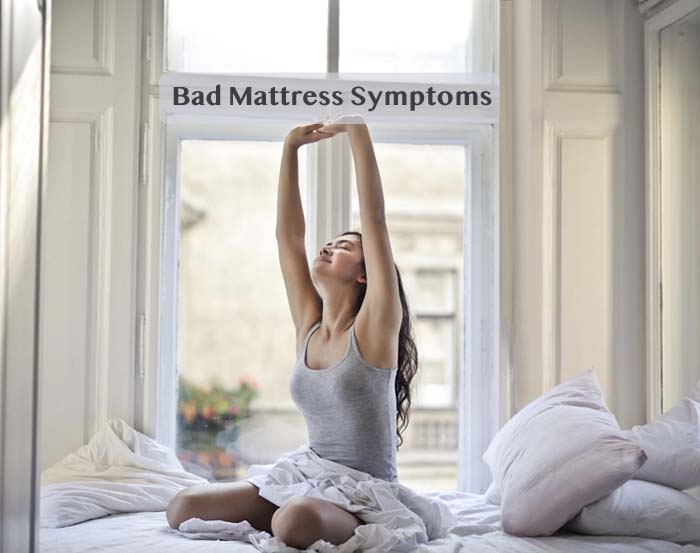5 Bad Mattress Symptoms: Do You Need a Mattress Replacement?
by | Last UpdatedAre you sleeping on a bad mattress?
Many bad mattress symptoms are just about impossible to miss. Chronic back pain? Crick in your neck? Waking up feeling stiff and sore all over? These are a few of the most common signs that you’re sleeping on a bad mattress. But what about other symptoms – the ones that come out of nowhere and seem to have no obvious connection to the bed where you spend a third of your life? If you’re sleeping on a mattress that has seen better days, it could be to blame, and it could be time for a mattress replacement.
Here are five of the most surprising bad mattress symptoms, plus some advice for keeping your new mattress in good condition once you’ve decided on a mattress replacement.

You’re experiencing sinus problems
Dust mites, pet dander, and mold are among the contaminants that might be lurking inside your mattress, leading to an increased risk of allergies and sinus trouble.
Pet dander
Many people sleep with their pets or at least share the same bedroom. Even if you’re not allergic to Fido or Fluffy, pet hair, saliva, dander, and even pollen that they carry into your house can lead to breathing issues in the bedroom.
Dust mites
According to the American Lung Association, eighty percent of homes in the US have at least one bed with a dust mite problem. This isn’t surprising, as they find dead skin cells and body oils appealing.
In an interview for a report by CNN, Dr. William Berger of the American Academy of Allergy, Asthma, & Immunology revealed that dust mites themselves aren’t to blame for breathing issues – instead, its their feces. “Dust mite droppings are highly allergenic,” he said, going on to mention that an allergy test is the best way to confirm whether you’re allergic.
Even if you don’t have an allergy to dust mite droppings, they’re still likely to cause irritation. Besides sinus problems, dust mites and their droppings can make skin conditions such as eczema worse.
The older the mattress, the greater the likelihood that it is full of dust mites and their droppings.
Fungi, mold, and mildew
Moisture from sweat and other spills can lead to the growth of fungi and mold inside your mattress, increasing the potential for allergies and sinus issues. If you see mildew, fungi, or mold on your mattress, treat it to a thorough cleaning and consider replacing it right away.
Your stress level has increased
In a study comparing sleep quality and stress in two groups of people sleeping in newer beds vs. older ones, researchers found that the group sleeping on old mattresses had greater discomfort and more stress overall than those who enjoyed newer bedding systems.
Since a lack of sleep can contribute to increased stress, it’s possible that your mattress could be to blame if you’re feeling more tension than usual and you’re having some trouble pinpointing the cause.
You’re plagued by fatigue
Even though you slept all night, you feel groggy and wiped out during your waking hours. If this sounds familiar, it’s possible that several different factors – all associated with your bad mattress – could be coming into play.
- Not being fully supported leads to tossing and turning, which can interrupt deep sleep cycles.
- Breathing difficulties brought on by microbes in your mattress can prevent sound sleep.
While poor sleep quality is associated with a number of health problems, getting adequate rest provides you with physical and emotional benefits. It’s important to make sure that you’re sleeping comfortably and if not, to identify and correct the cause. You’ll know you’re on target when you feel alert shortly after waking up, you have plenty of energy to get through the day, and you fall asleep comfortably when it’s time.
Falling asleep takes forever
While blue light from your TV, smartphone, or tablet might be to blame for your inability to drift off early enough to catch plenty of Z’s, it’s possible that your mattress could be to blame. In a study published by Sleep Science, a group of people who swapped out firm mattresses for medium-firm ones fell asleep in an average of 21 minutes instead of the previous average of 67 minutes. 
After sleeping on their new mattresses for four weeks, they noted that their neck and back pain dropped by more than 50 percent. It stands to reason that any discomfort associated with your mattress could be contributing to those hours spent lying awake when you’d like nothing more than to simply fall asleep. If you choose mattresses designed for lower back pain sufferers, you will get better results.
The mattress experts at SleepingCulture reiterate these findings, telling us that spending as much as you can afford on a bed is a good long-term investment in your health: “A bad mattress translates in an uncomfortable sleep, where you are moving around a lot and not enjoying deep, restful sleep.”
Deanne Halfpenny tells the Guardian, “Undisturbed sleep is important because of the fluctuating hormones that are released when we sleep. Disturbed sleep disrupts these patterns. Our bodies are constantly breaking down and rebuilding, and restorative sleep allows your muscles to relax and improves blood flow – [especially] to the discs in your back, which normally have poor blood flow. If your muscles are tense, you won’t get that restorative blood flow.”
Your memory isn’t what it used to be, and you have trouble concentrating
According to bedroomcritic.com, “Sleep plays a vital role in our ability to focus, think, and learn. For example, new information is consolidated into memories during REM sleep. As discomfort caused by an old mattress prevents deep sleep, it’s possible that memory problems and other cognitive issues might be linked to lack of rest”. The sleep experts go on to reveal the other signs indicating that your brain isn’t being properly recharged overnight:
- Irritability
- Low libido
- Anxiety
- Depression symptoms
- Forgetfulness
- Lower alertness
The way you feel in general can be a very good indicator of whether or not you’re getting the right amount of sleep. Since many of the symptoms associated with bad mattresses can also signify underlying health problems, it’s important to see your health care provider to rule out anything serious.
Bonus: You can see and feel signs that your mattress is bad.
In addition to bad mattress symptoms that have a negative effect your wellbeing, there are some other signs that it’s time to think about a mattress replacement.
The feel of your mattress has changed
Most mattresses have several layers including an upper comfort layer that’s designed to cradle your body. Under that, a firmer support layer keeps you from sinking into the mattress. The type of support layer depends on which type of mattress you have; for example, a hybrid mattress normally has individual springs underneath a layer of memory foam or similar material while many memory foam mattresses feature layers of firmer foam at their cores.
If you can feel the firm support layer underneath the soft upper layer, then it’s time to get a new mattress.
Your mattress is sagging
Saggy mattresses don’t provide the support your body needs. You may be able to buy a little time by rotating your mattress but just like other forms of deterioration, sagging is a clear sign that it’s time to think about a new mattress. Check out these mattresses that don’t sag if you want to buy a new one.
You can see an indentation long after you get up
Take a look at the surface of your mattress. If it’s been a while since you got up and you can still see the outline of your body in the mattress’s upper comfort layer, it’s a clear sign that your bed has seen better days. Rotating your mattress can increase comfort temporarily, but this is one of those bad mattress symptoms that indicates that time is running out and it’s time to research the latest mattresses.
What features should you look for when shopping for a new mattress?
In the not-so-distant past, there were only a few different mattress types to choose from. These days we have our pick of comfy hybrid mattresses, luxurious memory foam mattresses, decadent adjustable beds, classic innerspring mattresses with or without cozy pillow tops, and even organic mattresses made with natural materials like cotton, wool, and latex.
Whichever you prefer, make sure that the mattress meets your needs in terms of firmness. Check to see if it’s a good fit for your individual sleeping style. If you’re spending more than a few hundred dollars, take a good look at the warranty and in all cases, check to see if there’s a sleep trial available.
Preventing bad mattress symptoms in the future: How to make your new mattress last longer
Caring for your mattress helps it last longer, saving you money while ensuring that your body gets the support it needs for sound, restful sleep and the overall wellbeing that accompanies it.
Support your new mattress properly
When you buy a new mattress, check to see what type of foundation or base it requires and make sure that you’re supporting it correctly. If you’re using your old bedframe, inspect it for damage before setting up your new mattress since an unsupportive frame means your mattress will sag prematurely, failing to support your body and leading to serious discomfort.
Use a mattress pad
Remember those nasty dust mites we talked about earlier? Get a dust-mite resistant mattress topper or pad to keep them from invading and you’ll sleep better, longer. A good mattress pad is a worthwhile investment for other reasons; for example, it can provide protection from body oils, sweat, pet hair, odors, and spills.
Here are a few more things to look for in a mattress pad:
- Waterproof or at least moisture-resistant
- Breathable
- Washable
Like mattresses, mattress pads have come a long way. Some covers are suitable for integrating with smart homes and others are designed with unique comfort features. Be sure to wash your mattress pad regularly so that it stays fresh.
Related: Best Mattress Toppers For Side Sleepers – Buyer’s Guide and Our Picks
Rotate or turn your mattress regularly
While some mattresses are designed to be flipped completely over, others have only a single sleeping surface. Know which type you have and check the manufacturer’s recommendations for rotating or turning it. Most mattresses benefit from being rotated from top to bottom once every month to two months. Swapping head and foot positions gives the weight-bearing portions of your mattress a break and prevents the onset of sagging.
Clean your mattress periodically
Even when it’s protected by a cover, your mattress needs to be cleaned at least twice annually. Better yet, treat it to a thorough cleaning quarterly.
- Strip off all the bedding, including your mattress cover.
- Sprinkle the top of your mattress with baking soda and allow it to sit for at least 15 minutes.
- Use your vacuum’s upholstery attachment to vacuum the mattress; pay close attention to the seams.
- Replace bedding after it has been laundered.
Conclusion
Unfortunately, all mattresses deteriorate – even the most expensive ones. If you’re noticing signs of a bad mattress, do yourself a favor and start searching for a new one before things get even worse. Most mattresses are built to last an average of five to ten years, although some brands are guaranteed to provide comfort and support for longer periods.
The good news is that with proper care, your new mattress should serve you well for years to come – and now that you know the most common signs of a bad mattress, you’ll be able to start searching for the next mattress replacement before serious problems set in.





No Comments